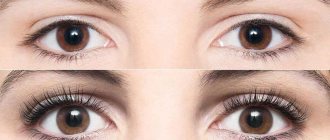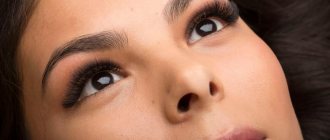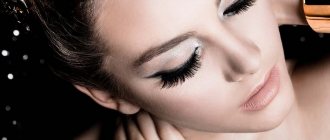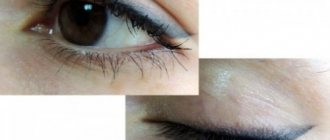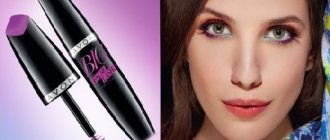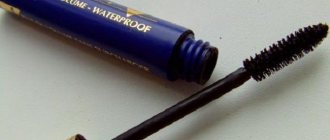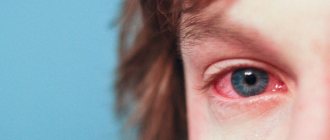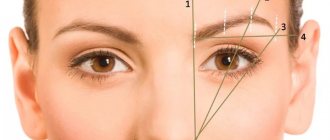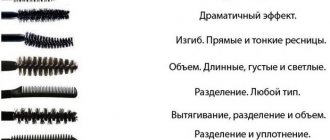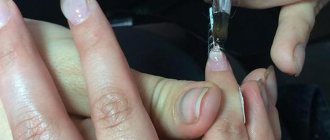Mascara advertisements keep telling us how one stroke of the brush will make our look enchanting and unforgettable. Of course, if you have naturally thick and long eyelashes, you will achieve the promised result, but for those with short and sparse eyelashes, no mascara will help. For such women there is extension. A couple of hours of work by a specialist will make your eyes more expressive. BUT! You need to be able to handle such beauty correctly; in addition, there are a number of contraindications to this procedure.
Seven-time champion in eyelash extensions Natalia Morozova told AiF.ru about the intricacies of .
Types of extensions
At the moment, there are two types of extensions: beam and eyelash extensions. Bundle extensions use bundles consisting of five to seven artificial hairs and silicone-based glue, which is easily washed off with water. This type of extension is not practical; wear lasts from one to three to four days if you make a correction. This creates the appearance of very thick, doll-like eyelashes.
Article on the topic
How to care for eyelashes at home?
With eyelash extensions, one artificial eyelash is used, which is attached to one natural one. Artificial eyelashes are similar in texture to natural ones; they come in different lengths, thicknesses and curves, so you can achieve various effects, from simulating natural ones to the effect of bright, false eyelashes. The wear lasts from three to seven weeks.
How to maintain rows when building extensions with a natural effect?
A smooth transition is one of the most important points in eyelash extensions with a natural effect. We have from 120 to 250 eyelashes on one eye. And if we slightly lift the upper eyelid with our finger, we will notice that all the hairs are located not in one row, but in several. Typically the number of rows is from three to five.
Let's give a simple example. When we start extensions from the inner corner of the eye with eyelashes of size 8 mm, our task is to make the smoothest possible transition from size 8 to 9. To do this, we do not make a sharp change in size in all rows at the same point, but change the size of the eyelash gradually. For example, on the top row we extend an extra 5-7 eyelashes, in the second row – an extra 4-6 hairs, in the third – 3-5 and so on, when we make a change in the bottom row. Schematically it will look like this:
How is marking done for eyelash extensions?
One of the key points when working with extension patterns is creating markings for a natural eyelash extension effect. The marking is the same extension scheme, but it is applied directly to the patches covering the lower eyelashes and serves as a kind of stencil for the master. It is always before your eyes, and the master can calmly concentrate on the work without losing sight of the diagram. Also, if you have enough experience, you can not build a diagram separately, but immediately make markings after you have examined the client’s eyelashes.
If you don't yet know how to create markup correctly, we will tell you in detail about each of its stages. It is worth clarifying in advance that all the specified parameters and numbers are just an example to show the general principle of creating markup, and should not be taken as a guide to action.
The steps for creating markings for natural and other effects are as follows:
- First, we ask the client to take the starting position: lying on her back with her eyes closed. Then we close the lower eyelashes using special pads or patches. Many specialists like to use elastic medical tape - it is inexpensive, enough for many uses, and the lower eyelashes are fixed securely.
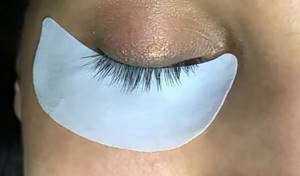
- Then you need to take any writing utensil - a pen, liner, marker or felt-tip pen with bright ink so that the markings are clearly visible. Draw two straight lines directly on the pad. One comes from the growth point of the last eyelash in the outer corner of the eye, the second - from the eyelash in the inner corner of the eye. The lines should be in the same direction in which these outer cilia grow. The length of the lines can be any, the main thing is that they are clearly distinguishable.
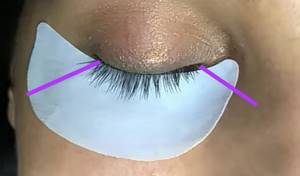
- Then we determine the center of the eyelash line - strictly in the middle between the two points where the extreme lines come from. From this point we draw another straight line and thereby divide the marking base into two approximately equal parts. The direction of the line must strictly coincide with the direction of growth of the eyelashes, which are located at the central point on the eyelash line.
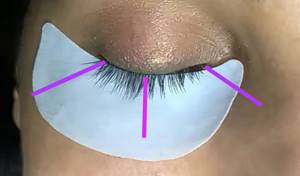
- Then you need to divide each half into smaller segments in the same way as we drew lines: we determine a point on the eyelash line and draw a line from it, the direction of which coincides with the direction of growth of the natural eyelash at this point. Standard recommendations when constructing markings are to divide the half of the base of the diagram, located closer to the inner corner of the eye, into three parts, and divide the second half, located closer to the outer corner of the eye, into four parts. If clients have small eyes, the number of segments can be reduced; if they have large eyes, the number of segments can be increased. In a natural effect, it is important that the length of the eyelash extensions be proportional to that of the natural hairs, so the final number of segments may not be 7, as in our case, but 4, 5 and even 9.
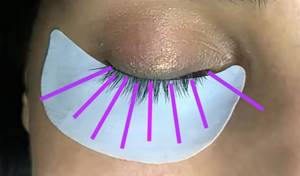
- The last stage is numbering. We assign a number to each resulting segment, which corresponds to the size of the artificial hairs that will be built up in this area. We put the numbers right inside the segments to make it easier to navigate. It is advisable to start numbering from the corners to the center - determine the length of the synthetic eyelashes in the inner corner, then in the outer corner, and gradually move towards the center, increasing the length. In natural-effect extensions, the longest hairs are usually located in that third of the lash line, which is located near the outer corner, but still closer to the center. Also, if you want to use not only different sizes in extensions, but also different bends and thicknesses of synthetic hairs, this must be indicated on the markings so as not to get confused. Therefore, you can write down the bend and thickness next to the length designation.
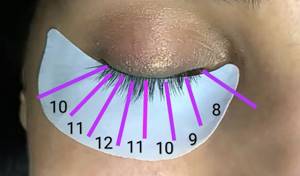
How to choose a master and salon
You need to find out how much time the master spends on the procedure. Even the most experienced specialist does classic extensions for at least an hour. If you are told that it will only take 30–40 minutes, this should alert you. You can forget about beautiful and high-quality extensions. In general, the duration of the process depends on the thickness of natural eyelashes, their structure, as well as the desired volume. I repeat once again that the minimum time spent on the procedure is only an hour, the maximum is 3.5 hours. In this case, the process should be absolutely painless.
Also, when choosing a master, it is important to find out what materials he works with. If they tell you that kolinsky, marmot, sable, silicone, and fox are used for extensions, this means that you are being misled. In fact, the eyelashes are made of synthetic monofilament. And of course, you shouldn’t go to a salon or studio if you haven’t read reviews about the master’s work.
Article on the topic
Eyes in 3D. How to make eyelashes brighter, more expressive and longer?
Signs of a wizard error
Good craftsmen and studios with a name and reputation provide a guarantee for their work. During the warranty period, if the client experiences discomfort or premature loss of eyelashes, he can safely contact the specialist with questions. This period can range from 1 to 7 days, depending on the studio’s policy or the master’s self-confidence as a professional. If eyelash loss is not caused by a technician's error, the warranty does not apply. So how to understand what the reason is?
The main signs of a wizard error:
- Discomfort when opening or closing the eye. Eyelash extensions should not be felt. Undoubtedly, only after making eyelashes for the first time, the client can feel and even see them. But it shouldn't be painful or uncomfortable. If such sensations arise, you must inform the master about this, just as the master himself must inquire about the client’s comfort at the end of the procedure. If discomfort occurs somewhere, be sure to check the eyelashes for the presence of glue. They are the ones that can cause an unpleasant feeling of tightness, because not all small vellus or anagens can be seen with the naked eye. Tingling can also cause an irregular indentation, which, when closing the eye, scratches the mucous membrane.
- Eyelashes fall out without their own in large numbers. This is a twofold situation, because the client may also be guilty of this, wittingly or unwittingly. For example, hormonal imbalance, recently done eyelash lamination, or an alcoholic party the day before can cause shedding. Shedding means the loss of 3 or more eyelashes or tufts per day without their own cilia. They simply “slip” off the native eyelash, which repels the foreign object without adhering to the glue. This may be a big mistake on the part of the specialist - insufficient cleansing of the native eyelash before the procedure and a small amount of degreaser applied to the eyelash. A professional lash maker can recognize his mistake, or conclude that the human body is “to blame.” Then the solution to the issue is discussed and either a correction is made (correction of the master’s mistake).
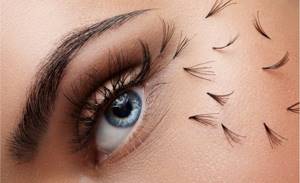
- As eyelashes grow, they become very twisted and stick into the eyes. This, of course, is no longer a warranty case, but it is also not a pleasant situation. Why might this happen? The eyelashes were attached long enough or their own eyelash grew rapidly. Professional hairdressers use adapted extension technology specifically to prevent the eyelash from sagging as it grows. In it, the longest eyelashes are attached to telogens, which are designed to quickly fall out and not disturb the eyelash row of the grown long ones, while anagens with short and catogens with medium cilia will just grow to the desired length. To choose the right eyelash length, there are entire separate courses taught by teachers, and not all masters can immediately apply this complex extension technology.
What not to do after extensions?
After eyelash extensions, you need to remember the rules for caring for them. For two to three days you will have to forget about visiting the spa, bathhouse, sauna and solarium (sunbathing is not recommended not only after, but also before the procedure). Do not use eyelash nourishing oils, greasy creams or cosmetics. When washing your face, do not rub your eyes too hard and do not try to remove eyelashes yourself. Of course, this can be done, but only with a special tool. Since most solvents cause a burning sensation when they come into contact with the mucous membrane of the eye, it is better if the procedure is carried out by a specialist; it will take only 10–20 minutes.
Contraindications
Recommendations regarding contraindications will help potential clients determine whether they have a condition that makes it worth visiting a lash maker or not. The best option is to contact a dermatologist, cosmetologist or extension specialist in advance, who will provide qualified advice. There are a number of contraindications to the procedure, which should be treated carefully and carefully .
1. It is not recommended to carry out extensions for persons suffering from acute respiratory diseases. Even a cold, runny nose, or cough can interfere with safety. These irritants provoke discomfort during the entire procedure. Watery eyes will cause poor-quality adhesion of the glue.
It is unsafe to do the extension procedure if you have a runny nose, cough, or watery eyes.
2. Persons with diseases of the eyes and skin of the eyelids - conjunctivitis, eyelash mites - are not allowed to participate . External interference in diseased eyes will provoke a worsening of the clinical picture of the disease. Extensions are done only on healthy eyes and eyelids.
Eye diseases are contraindications for eyelash extensions.
3. Eyelashes do not adhere well to oily skin of the face and eyelids . This is not a ban, but the validity period of artificial samples will be halved.
4. You cannot do extensions if you are individually intolerant to drugs or their components - this applies to glue and all liquids.
Before undergoing eyelash extensions, you need to know about your health status.
5. Girls with sensitive eyes should be careful about the procedure. A qualified technician will know how to properly attach eyelashes without pain, but the process will take longer. Sensitive eyes will twitch nervously, interfering with the process. This can cause glue vapors to get into your eyes and cause redness.
Eyelash extensions are contraindicated for girls with sensitive eyes
How to restore eyelashes after failed extensions?
If you are faced with extensions in which certain rules were violated, causing injury to the eyelashes, you must follow the following recommendations for nutrition and strengthening:
- apply castor, burdock, almond oil to the roots of the eyelashes at night for one to two weeks;
- use special serums for the growth and nutrition of eyelashes and eyebrows;
- apply compresses from chamomile and sage decoctions (they not only nourish the eyelashes, but also tone the skin of the eyelids).
Expert commentary
Ophthalmologist Natalya Piotrovskaya: This issue should be approached with special caution by people suffering from any allergy, not necessarily the ocular form.
Since false eyelashes are attached to the eyelids with a special means, there is a risk of an allergic reaction to this chemical, which will manifest itself as redness, swelling and itching of the eyelids; in the worst case, marginal keratitis may develop (severe inflammation of the cornea, requiring long-term treatment). If you experience the first manifestations of an allergic reaction, you must immediately remove the artificial eyelashes and consult an ophthalmologist.
